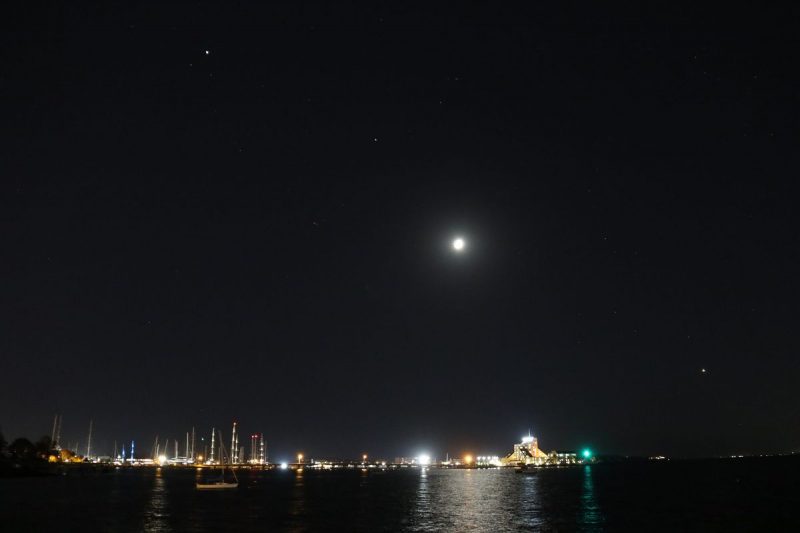
Planet-observing is easy and fun
This has been a great week for planet-observing! And it’s going to stay good between now and the end of 2021. The moon passed the brightest planet, Venus, earlier this week. And it’ll be sweeping past Jupiter and Saturn tonight and tomorrow (November 10 and 11, 2021). Sometimes when you’re out gazing at the brightest objects in the night sky, you’re seeing the planets without knowing it. There are five planets you can view without optical aid: Mercury, Venus, Mars, Jupiter and Saturn. These are the classical planets that the ancients knew. They watched these planets “wander” across the sky, seemingly unattached to the stars and constellations. The word planet is from the ancient Greek word planete, meaning wanderer.
For the outer planets (Mars, Jupiter, Saturn, Uranus, Neptune), the best viewing happens around their yearly oppositions, when Earth is passing between that world and the sun, placing it opposite the sun in our sky. A planet at opposition rises when the sun sets and is visible all night. The inner planets (Venus and Mercury) are most easily seen around their greatest elongations. The inner planets stay near the sunrise or sunset. Greatest elongation is when their distance from the sun on our sky’s dome is greatest.
But any time you’re under the night sky, and the clouds have parted, is a great time to try to look for planets. There’s often a planet or two, or more, up in some part of the sky for much of the night (if not all night). The bright planets are often (but not always) brighter than the brightest stars. And you can see the most distant and dimmest major planets too, as long as you have a pair of binoculars. Keep reading to meet each planet and learn a few tips on what to look for.
How will you know where to find planets at any given time? EarthSky’s visible planet guide – updated monthly – is a good place to start.
Mercury: Never far from the sun
Of the five classical planets, Mercury is the most elusive. By that we mean you have to look for it in the right place and at the right time. Because Mercury is innermost to the sun, we on Earth never see Mercury stray far from the sun in our night sky. Mercury is sometimes visible after sunset, when it’s following the sun below the western horizon. Or, it’s up in the east, leading the sun up from behind the dawn horizon.
TIP:
It’s fun to observe Mercury from the time it first appears – either in the west after sunset or east before dawn – through the time it’s farthest from the sun (greatest elongation) – and back to when it disappears again into the sunset or sunrise glare. During these times, Mercury makes a great loop in the morning or evening twilight sky. Every Mercury apparition is a little different, depending on the time of year, your location on Earth and other factors. Mercury is just now fresh from a grand greatest elongation in the morning sky. It’s heading toward another greatest elongation in the evening sky (west after sunset), on January 7, 2022. Mercury isn’t visible now, but start watching for it after sunset in the last few days of December, as 2021 ends.
TIP:
Mercury shows phases, like the moon. Once you learn to watch Mercury with your eye, try some optical aid. Just be sure that the sun is completely below the horizon before you start searching for Mercury with binoculars or a telescope. Mercury and Venus, being inner planets, show phases like the moon. This happens around the time of their inferior conjunctions (when they pass between us and the sun). Mercury’s next inferior conjunction will be January 23, 2022. So that means you might see Mercury phases next as the planet descends toward the sun, say, beginning around mid-January. You’ll need a telescope to see the phases of Mercury.
TIP:
As Mercury comes and goes in our sky – and as we and it travel around the sun – a telescope will show you that Mercury’s angular diameter (its size as seen on our sky’s dome) varies from 4.5 to 13.0 arcseconds. As you might see, Mercury’s size in our sky depends on how close Earth and Mercury are in their respective orbits.
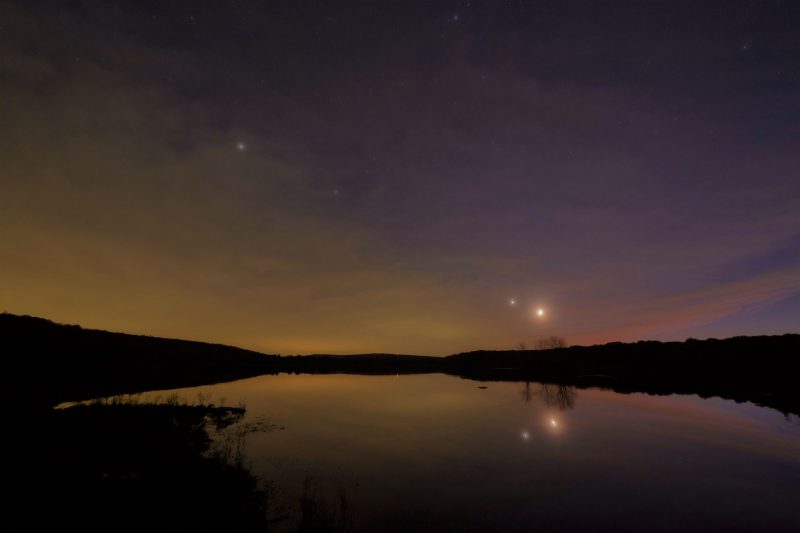
Venus: Brightest planet
Venus is the brightest planet we can see from Earth. It outshines all the stars. When it’s close to the horizon (which it often is, being closer to the sun than Earth), people frequently mistake it for a plane with its landing lights on. Venus is in the evening sky now, incredibly bright, near the western horizon after sunset.
This neighboring planet is so bright because of its thick clouds and because of how close the planet is to us. It’s our nearest planetary neighbor in the solar system.
TIP:
Venus looks especially beautiful when it pairs up with a crescent moon or another planet. Visit EarthSky’s visible planet guide regularly to learn the dates of those pairings.
TIP:
Like Mercury, through a telescope, Venus shows phases. Its apparent size in our sky changes, much like Mercury, but even more dramatically than Mercury. Venus is so nearby and so bright that, even with steadily held binoculars, you can sometimes see that Venus is something other than round. If you looked at Venus through a telescope tonight (November 10, 2021), you’d see it in a 43%-illuminated phase. The phase of Venus will shrink between now and the end of 2021. Try following the shrinking phase of Venus throughout December. Venus will then pass between us and the sun on January 9, 2022. Afterwards, it’ll pop up quickly in the east before dawn.
TIP:
Between now and the year’s end, Venus will undergo what astronomers call greatest brilliancy. That’s when the overall largeness of its disk will balance with planet’s shrinking phase, so that we see Venus as an eerie bright light low in our twilight sky. Greatest brilliancy will happen next in early December 2021. Watch Venus get brighter (and closer to the sunset) throughout November. And read more about its greatest brilliancy here.
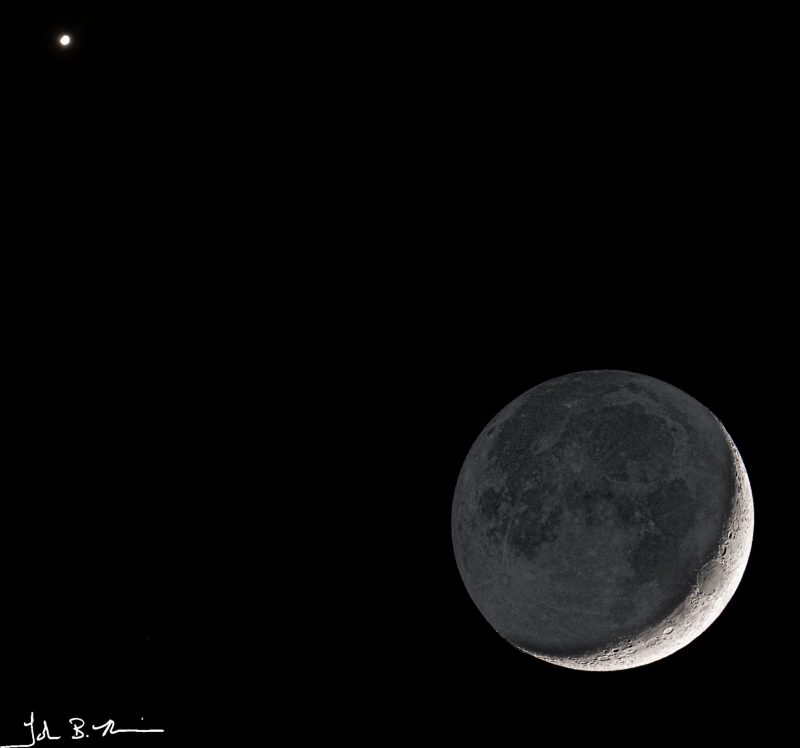
Mars: The red planet
Mars is the most fascinating of the visible planets to watch with the unaided eye. That’s because it’s the planet next-outward from Earth in orbit around the sun. It’s not a very large world (smaller than Earth), and so its brightness changes dramatically throughout its visible cycle.
TIP:
Mars is behind the sun now, but it’ll be coming back into view, in the east before dawn, by 2021’s end. That’s when it’ll begin another cycle of visibility that’ll culminate with its opposition in December 2022.
TIP:
The most distinctive feature of Mars to the unaided eye is its reddish color. When you view Mars from a dark-sky location, its color really pops. The red color is what drew the ancients to name the planet for the god of war. Iron oxide in the rocks, the same compound that makes rust and blood reddish on Earth, makes the surface of Mars look red, too.
TIP:
Binoculars mounted in a tripod can show you Mars’ round disk shape. Binoculars will also accentuate Mars’ red color.
TIP:
If you want to see surface features on Mars, you’re going to need a telescope. White patches on Mars are generally ice caps or clouds. Percival Lowell thought the dark areas of Mars were canals built by Martians to carry water across the surface. Others thought the dark spots were a sign of vegetation. Various spacecraft to the red planet revealed that dark markings come from a variety of sources, such as dark volcanic basalt or landslides, but not from life.
Jupiter: Biggest, with visible moons
Jupiter is in the evening sky now, not far from bright Venus. Jupiter and Venus are the two brightest planets, and they’re both much brighter than all the stars. You can’t miss them!
TIP:
Even the smallest telescope will reveal the four largest moons of Jupiter. Binoculars might also let you glimpse a moon or two, if you have a dark sky. The Galilean moons, as they’re known, are Io, Europa, Ganymede and Callisto. Nightly observing will show them constantly changing places as they whirl around the giant planet, sometimes passing in front of or behind Jupiter. These occultations can also involve the shadows of the moons.
TIP:
The surface of Jupiter is also worth a look through a telescope. You’ll need a larger size telescope to make out the Great Red Spot, but smaller scopes will still show you the light and dark belts and zones that ring the giant planet.
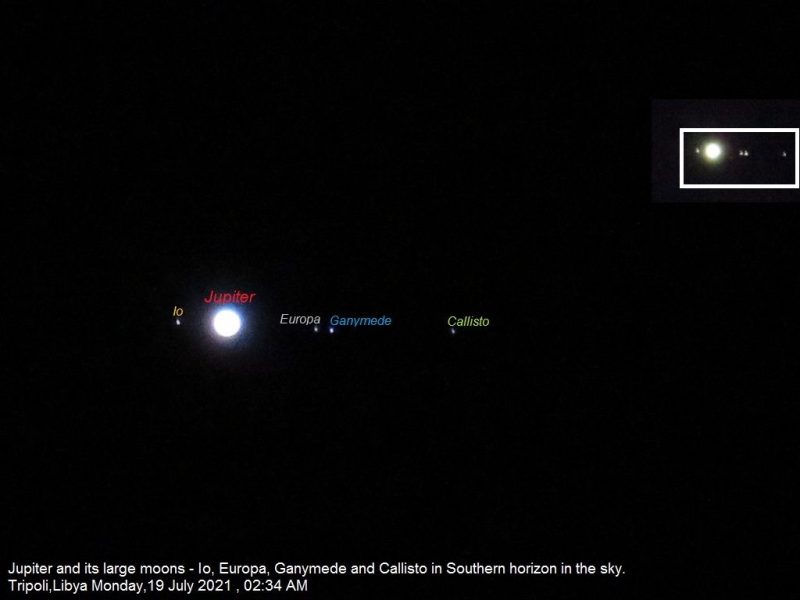
Saturn: Golden color, magnificent rings
Saturn is the faintest of the bright planets, but it’s been noticeable throughout 2021 near Jupiter. And it’s going to become more noticeable before this year ends. By early December, Jupiter, Saturn and Venus will be about equidistant from one another in the western twilight sky. You can’t see Saturn’s rings without a telescope. What can you notice about Saturn with the eye alone? Be sure to notice its golden color and steady light.
TIP:
Saturn is called the planet of the rings with good reason. The rings of Saturn are magnificent! As the years pass, and we and Saturn both orbit the sun, the angle of the rings changes with respect to Earth. Sometimes we see the north face of the rings, and sometimes the south face. Sometimes, the rings turn their razor-thin edge to us, and virtually disappear. We can’t overstate how glorious Saturn’s rings are. They make the planet look twice as big as it would without them. On a night of good seeing, with a small telescope, you can make out a gap in the rings, called Cassini’s Division. You can also look for a shadow of the rings cast onto the planet, or a shadow of the planet cast onto the rings.
TIP:
Saturn’s large moon, Titan, can also be seen through a telescope.
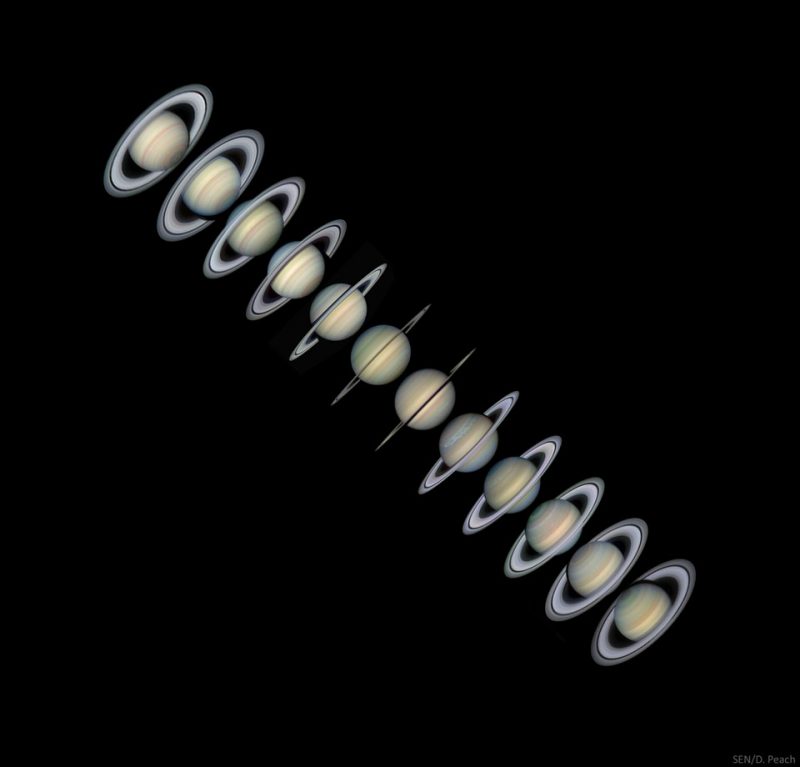
Uranus: A different pale blue dot
Carl Sagan described Earth as a pale blue dot when looking at a Voyager 1 image of our planet as the spacecraft sped out of the solar system. For us on Earth looking out at the solar system, the seventh planet from the sun, Uranus, appears as nothing more than a pale blue dot. And that’s through a telescope! With the eye alone, you can sometimes pick out Uranus from among the stars. But, to do it, you need absolutely pristine, dark skies.
TIP:
With a telescope, the surface features and rings of Uranus can’t be seen. But some larger telescopes will pick up a couple of Uranus’ moons. A medium to large size telescope might show you Titania and Oberon. They are the largest moons of Uranus and orbit far enough from the planet that you can distinguish them as separate points of light.
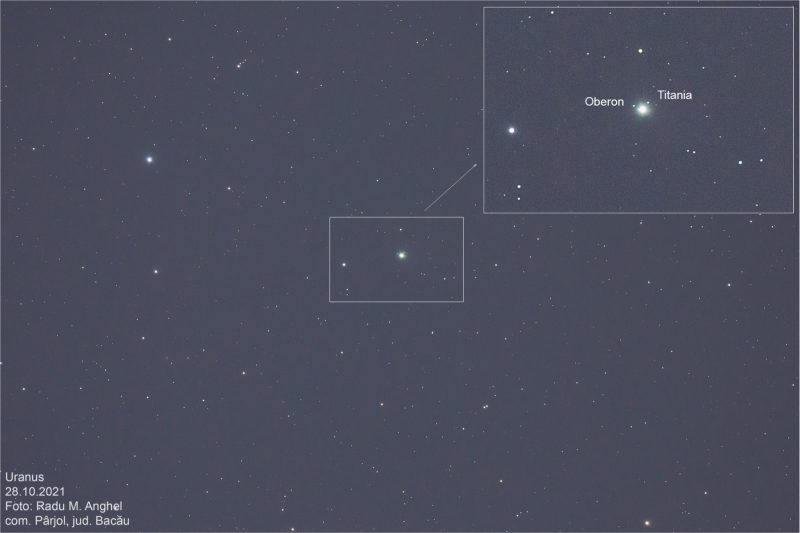
Neptune: Farthest major planet from the sun
Neptune is the biggest observing challenge on the list, but it’s not hard to see with optical aid and a guide star or planet. When Neptune is close to an object that’s easy to pick out of the night sky, say, Venus, you can pick it up easily in binoculars. Keen eyesight will show it as a disk with a darker blue hue.
TIP:
Jupiter and Neptune will be six arcminutes apart before sunrise on April 12, 2022. Neptune will be just below Jupiter, but the sun creeping toward the horizon will still make it a challenge.
Bottom line: Get our top tips for planet observing, from innermost and elusive Mercury out to faint blue Neptune … and everything in between.
The post Planet-observing is easy: Top tips here first appeared on EarthSky.
from EarthSky https://ift.tt/3oiLa8P

Planet-observing is easy and fun
This has been a great week for planet-observing! And it’s going to stay good between now and the end of 2021. The moon passed the brightest planet, Venus, earlier this week. And it’ll be sweeping past Jupiter and Saturn tonight and tomorrow (November 10 and 11, 2021). Sometimes when you’re out gazing at the brightest objects in the night sky, you’re seeing the planets without knowing it. There are five planets you can view without optical aid: Mercury, Venus, Mars, Jupiter and Saturn. These are the classical planets that the ancients knew. They watched these planets “wander” across the sky, seemingly unattached to the stars and constellations. The word planet is from the ancient Greek word planete, meaning wanderer.
For the outer planets (Mars, Jupiter, Saturn, Uranus, Neptune), the best viewing happens around their yearly oppositions, when Earth is passing between that world and the sun, placing it opposite the sun in our sky. A planet at opposition rises when the sun sets and is visible all night. The inner planets (Venus and Mercury) are most easily seen around their greatest elongations. The inner planets stay near the sunrise or sunset. Greatest elongation is when their distance from the sun on our sky’s dome is greatest.
But any time you’re under the night sky, and the clouds have parted, is a great time to try to look for planets. There’s often a planet or two, or more, up in some part of the sky for much of the night (if not all night). The bright planets are often (but not always) brighter than the brightest stars. And you can see the most distant and dimmest major planets too, as long as you have a pair of binoculars. Keep reading to meet each planet and learn a few tips on what to look for.
How will you know where to find planets at any given time? EarthSky’s visible planet guide – updated monthly – is a good place to start.
Mercury: Never far from the sun
Of the five classical planets, Mercury is the most elusive. By that we mean you have to look for it in the right place and at the right time. Because Mercury is innermost to the sun, we on Earth never see Mercury stray far from the sun in our night sky. Mercury is sometimes visible after sunset, when it’s following the sun below the western horizon. Or, it’s up in the east, leading the sun up from behind the dawn horizon.
TIP:
It’s fun to observe Mercury from the time it first appears – either in the west after sunset or east before dawn – through the time it’s farthest from the sun (greatest elongation) – and back to when it disappears again into the sunset or sunrise glare. During these times, Mercury makes a great loop in the morning or evening twilight sky. Every Mercury apparition is a little different, depending on the time of year, your location on Earth and other factors. Mercury is just now fresh from a grand greatest elongation in the morning sky. It’s heading toward another greatest elongation in the evening sky (west after sunset), on January 7, 2022. Mercury isn’t visible now, but start watching for it after sunset in the last few days of December, as 2021 ends.
TIP:
Mercury shows phases, like the moon. Once you learn to watch Mercury with your eye, try some optical aid. Just be sure that the sun is completely below the horizon before you start searching for Mercury with binoculars or a telescope. Mercury and Venus, being inner planets, show phases like the moon. This happens around the time of their inferior conjunctions (when they pass between us and the sun). Mercury’s next inferior conjunction will be January 23, 2022. So that means you might see Mercury phases next as the planet descends toward the sun, say, beginning around mid-January. You’ll need a telescope to see the phases of Mercury.
TIP:
As Mercury comes and goes in our sky – and as we and it travel around the sun – a telescope will show you that Mercury’s angular diameter (its size as seen on our sky’s dome) varies from 4.5 to 13.0 arcseconds. As you might see, Mercury’s size in our sky depends on how close Earth and Mercury are in their respective orbits.

Venus: Brightest planet
Venus is the brightest planet we can see from Earth. It outshines all the stars. When it’s close to the horizon (which it often is, being closer to the sun than Earth), people frequently mistake it for a plane with its landing lights on. Venus is in the evening sky now, incredibly bright, near the western horizon after sunset.
This neighboring planet is so bright because of its thick clouds and because of how close the planet is to us. It’s our nearest planetary neighbor in the solar system.
TIP:
Venus looks especially beautiful when it pairs up with a crescent moon or another planet. Visit EarthSky’s visible planet guide regularly to learn the dates of those pairings.
TIP:
Like Mercury, through a telescope, Venus shows phases. Its apparent size in our sky changes, much like Mercury, but even more dramatically than Mercury. Venus is so nearby and so bright that, even with steadily held binoculars, you can sometimes see that Venus is something other than round. If you looked at Venus through a telescope tonight (November 10, 2021), you’d see it in a 43%-illuminated phase. The phase of Venus will shrink between now and the end of 2021. Try following the shrinking phase of Venus throughout December. Venus will then pass between us and the sun on January 9, 2022. Afterwards, it’ll pop up quickly in the east before dawn.
TIP:
Between now and the year’s end, Venus will undergo what astronomers call greatest brilliancy. That’s when the overall largeness of its disk will balance with planet’s shrinking phase, so that we see Venus as an eerie bright light low in our twilight sky. Greatest brilliancy will happen next in early December 2021. Watch Venus get brighter (and closer to the sunset) throughout November. And read more about its greatest brilliancy here.

Mars: The red planet
Mars is the most fascinating of the visible planets to watch with the unaided eye. That’s because it’s the planet next-outward from Earth in orbit around the sun. It’s not a very large world (smaller than Earth), and so its brightness changes dramatically throughout its visible cycle.
TIP:
Mars is behind the sun now, but it’ll be coming back into view, in the east before dawn, by 2021’s end. That’s when it’ll begin another cycle of visibility that’ll culminate with its opposition in December 2022.
TIP:
The most distinctive feature of Mars to the unaided eye is its reddish color. When you view Mars from a dark-sky location, its color really pops. The red color is what drew the ancients to name the planet for the god of war. Iron oxide in the rocks, the same compound that makes rust and blood reddish on Earth, makes the surface of Mars look red, too.
TIP:
Binoculars mounted in a tripod can show you Mars’ round disk shape. Binoculars will also accentuate Mars’ red color.
TIP:
If you want to see surface features on Mars, you’re going to need a telescope. White patches on Mars are generally ice caps or clouds. Percival Lowell thought the dark areas of Mars were canals built by Martians to carry water across the surface. Others thought the dark spots were a sign of vegetation. Various spacecraft to the red planet revealed that dark markings come from a variety of sources, such as dark volcanic basalt or landslides, but not from life.
Jupiter: Biggest, with visible moons
Jupiter is in the evening sky now, not far from bright Venus. Jupiter and Venus are the two brightest planets, and they’re both much brighter than all the stars. You can’t miss them!
TIP:
Even the smallest telescope will reveal the four largest moons of Jupiter. Binoculars might also let you glimpse a moon or two, if you have a dark sky. The Galilean moons, as they’re known, are Io, Europa, Ganymede and Callisto. Nightly observing will show them constantly changing places as they whirl around the giant planet, sometimes passing in front of or behind Jupiter. These occultations can also involve the shadows of the moons.
TIP:
The surface of Jupiter is also worth a look through a telescope. You’ll need a larger size telescope to make out the Great Red Spot, but smaller scopes will still show you the light and dark belts and zones that ring the giant planet.

Saturn: Golden color, magnificent rings
Saturn is the faintest of the bright planets, but it’s been noticeable throughout 2021 near Jupiter. And it’s going to become more noticeable before this year ends. By early December, Jupiter, Saturn and Venus will be about equidistant from one another in the western twilight sky. You can’t see Saturn’s rings without a telescope. What can you notice about Saturn with the eye alone? Be sure to notice its golden color and steady light.
TIP:
Saturn is called the planet of the rings with good reason. The rings of Saturn are magnificent! As the years pass, and we and Saturn both orbit the sun, the angle of the rings changes with respect to Earth. Sometimes we see the north face of the rings, and sometimes the south face. Sometimes, the rings turn their razor-thin edge to us, and virtually disappear. We can’t overstate how glorious Saturn’s rings are. They make the planet look twice as big as it would without them. On a night of good seeing, with a small telescope, you can make out a gap in the rings, called Cassini’s Division. You can also look for a shadow of the rings cast onto the planet, or a shadow of the planet cast onto the rings.
TIP:
Saturn’s large moon, Titan, can also be seen through a telescope.

Uranus: A different pale blue dot
Carl Sagan described Earth as a pale blue dot when looking at a Voyager 1 image of our planet as the spacecraft sped out of the solar system. For us on Earth looking out at the solar system, the seventh planet from the sun, Uranus, appears as nothing more than a pale blue dot. And that’s through a telescope! With the eye alone, you can sometimes pick out Uranus from among the stars. But, to do it, you need absolutely pristine, dark skies.
TIP:
With a telescope, the surface features and rings of Uranus can’t be seen. But some larger telescopes will pick up a couple of Uranus’ moons. A medium to large size telescope might show you Titania and Oberon. They are the largest moons of Uranus and orbit far enough from the planet that you can distinguish them as separate points of light.

Neptune: Farthest major planet from the sun
Neptune is the biggest observing challenge on the list, but it’s not hard to see with optical aid and a guide star or planet. When Neptune is close to an object that’s easy to pick out of the night sky, say, Venus, you can pick it up easily in binoculars. Keen eyesight will show it as a disk with a darker blue hue.
TIP:
Jupiter and Neptune will be six arcminutes apart before sunrise on April 12, 2022. Neptune will be just below Jupiter, but the sun creeping toward the horizon will still make it a challenge.
Bottom line: Get our top tips for planet observing, from innermost and elusive Mercury out to faint blue Neptune … and everything in between.
The post Planet-observing is easy: Top tips here first appeared on EarthSky.
from EarthSky https://ift.tt/3oiLa8P

Aucun commentaire:
Enregistrer un commentaire